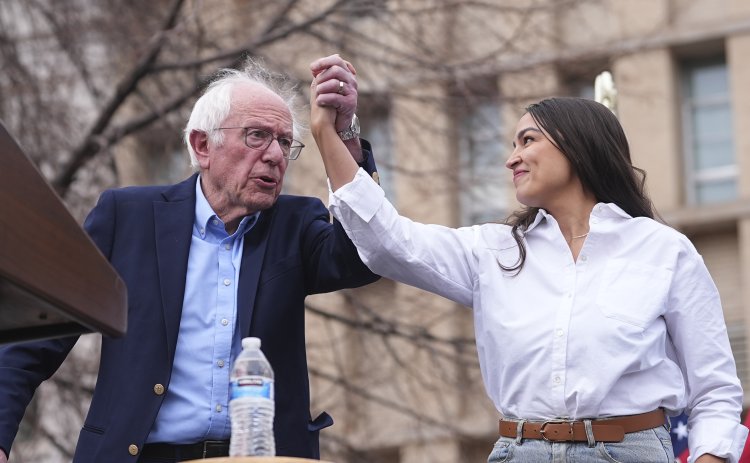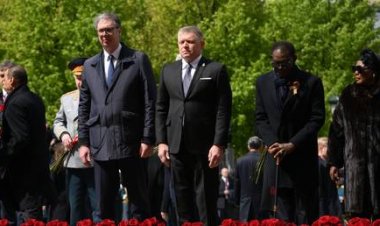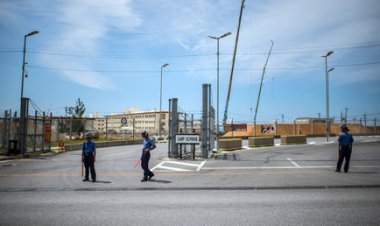The True Significance of the Massive Rallies Held by Bernie Sanders and Alexandria Ocasio-Cortez
The two progressives are invigorating a party that has felt exhausted and enraged during the second Trump era.

The two influential figures have been traveling extensively, drawing some of the largest crowds of their careers. Their rallies currently surpass any other events organized by Democrats, prompting notice from party leaders across the spectrum.
For progressives, this moment represents a rejuvenation. Many Democrats, including those affiliated with the party establishment, are relieved to see a potential rallying cry emerging as a counter to the Republican Party's dominance in the federal government.
“I'm so proud and so excited by every Democrat at every single level who is getting out there,” remarked Malcolm Kenyatta, a vice chair of the Democratic National Committee who has previously criticized Sanders. “This is not left versus right. This is about flight versus fight.”
According to Sanders’ advisers, approximately two-thirds of attendees at his recent events are individuals who had never attended or supported him before. Progressives view this as an opportunity to steer the party in a more populist direction.
However, this shift concerns some moderate Democrats, who worry that Sanders and Ocasio-Cortez could pull the party further left at a time when it lacks direction, potentially alienating swing voters.
Matt Bennett, a vice president at the center-left organization Third Way, expressed his hope that the rallies are “giving people an outlet for that anger” directed at Trump. Still, he cautioned that “crowd size is the worst metric in American politics” and emphasized the need to avoid the mistakes of the far left that contributed to the party's current struggles.
For many in Sanders’ circle and other liberals, the enthusiastic audiences with Ocasio-Cortez represent a long-awaited moment.
Despite Sanders’ familiar speeches addressing the challenges faced by American workers and the growing influence of the billionaire class, the composition of the Democratic base has evolved. Following President Donald Trump’s election, Democratic voters have expressed their fury towards their own leaders, creating turmoil at town halls and diminishing the party's approval ratings.
“There is a very important project of transforming the Democratic Party, or frankly bringing the Democratic Party back to its FDR-era roots,” stated Rep. Greg Casar, chair of the Congressional Progressive Caucus, who has joined Sanders and Ocasio-Cortez on their tour.
Sanders’ team revealed that their tour aims not only to inspire but also to provide a vision for the Democratic Party's future. In a memo sent to supporters, top aide Faiz Shakir posited that the nation is experiencing a “populist revolt,” highlighting Sanders' favorable poll numbers compared to the Democratic Party's low approval ratings.
The immediate goals of Sanders’ “Fight Oligarchy” tour, which has included visits to states like Nebraska, Iowa, Michigan, and Arizona, include pressuring Republican lawmakers in critical districts to oppose reductions to Medicaid, tax benefits for the wealthy, and other GOP fiscal proposals.
The Sanders campaign has compiled contact information for event attendees and is actively encouraging them via email and text to reach out to their members of Congress regarding the GOP budget plan. Additionally, they are hiring organizers in some of the states featured on the tour.
Ari Rabin-Havt, Sanders' former deputy campaign manager, attended several recent rallies and shared that he spoke with many individuals who had not supported Sanders in previous elections. Many expressed disappointment regarding the lack of energy within the Democratic Party since 2017, when widespread protests occurred against Trump after his initial election.
“A lot of the people I spoke to were there because they saw two leaders who represented their desire to fight,” he remarked.
The Sanders and Ocasio-Cortez tour, anticipated to include more stops in the future, also coincides with the progressive movement's preparation for a post-Sanders landscape.
At 83, Sanders is reportedly uninterested in pursuing a presidential run in 2028, raising concerns on the left about future leadership. Supporters of Ocasio-Cortez have suggested her as a possible candidate for the presidency, and there have been calls for her to challenge Senate Minority Leader Chuck Schumer in the 2028 primary in New York after he frustrated party members by supporting a GOP funding bill aimed at averting a government shutdown.
“People are looking for a fighter. That’s core to who she is,” commented Lauren Hitt, a former top aide to Ocasio-Cortez. “She's never been someone who's afraid to speak up and speak out. And I think there’s a real desire for more leaders like this.”
Regardless of her future political trajectory, Ocasio-Cortez is currently captivating audiences from her position in Congress, sharing the spotlight with Sanders. Joe Caiazzo, a former aide to Sanders’ presidential campaigns, suggested that the resonating messages from both leaders can be attributed, in part, to the current state of governance in Washington.
“We're living this oligarchy right now,” he asserted. “Everything that Bernie believes and warned us about was on display at the inauguration when the oligarchs of this country sat in front of the Cabinet nominees.”
Sophie Wagner for TROIB News












